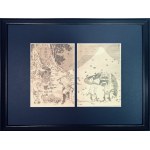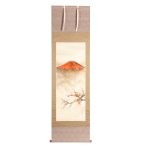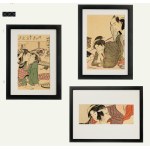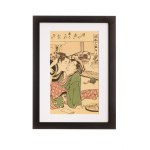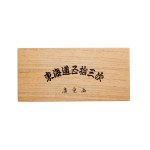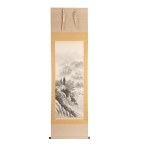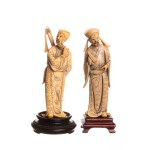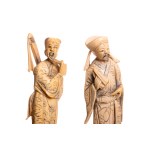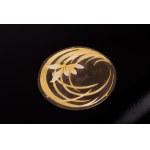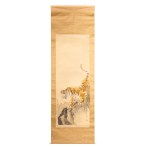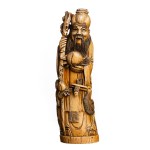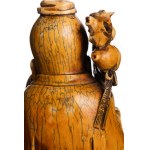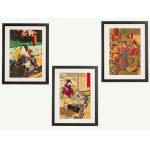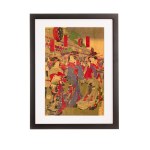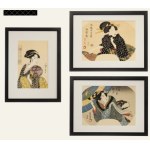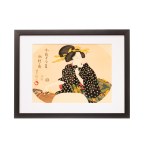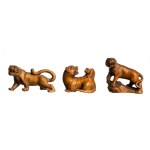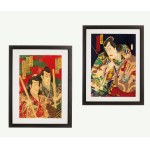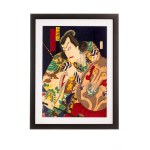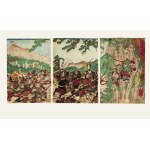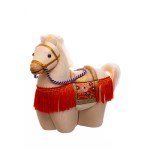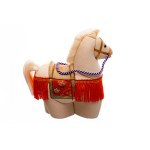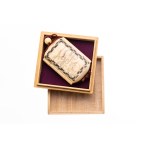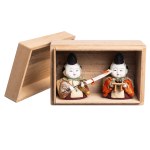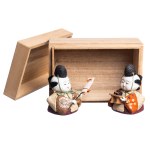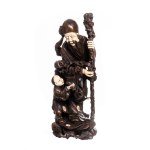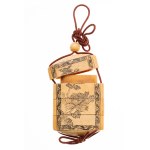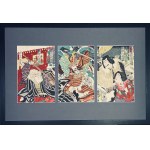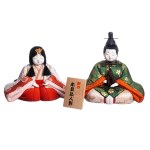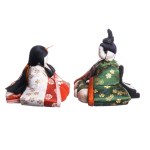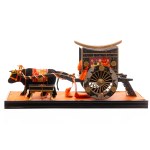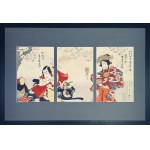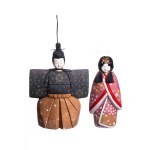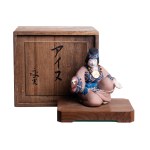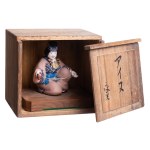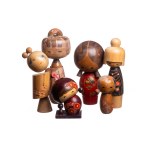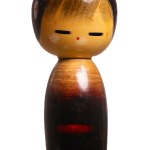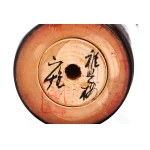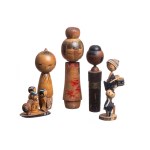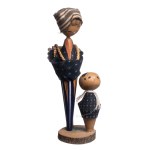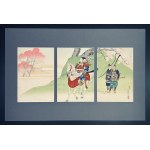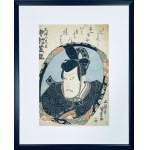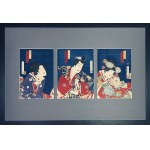Asian art auctions
"One Hundred Views of Mount Fuji" (FugakuHyakkei) is a famous series of woodcuts byKatsushiki Hokusai ( 1760-1849), the world's most reveredukiyo-eartist. After the success of his masterpiece "Thirty-six Views of Mount Fuji," Hokusaipostedto expand the series toone hundredviews, and in 1834he began publishing this magnificent series of one hundred black-and-white works. Woodcutblack and white ...
Hanging scroll (kakemono), a colorful ink painting on silk. The landscape depicts one of Japan's most famous shots of Mount Fuji - the so-called "Red Fuji" (Aka Fuji), visible at dawn when the peak takes on an intense purple hue. At the bottom of the composition is a branch of a flowering plum tree with white and red flowers (kōhaku bai), symbolizing prosperity, joy and the coming of spring. ...
A set of three colorful ukiyo-e woodcuts depicting intimate scenes of two lovers. The compositions are in Shunga's characteristic style, with an emphasis on subtle emotion, elegant kimonos and clear lines emphasizing facial features. Each of the woodcuts is framed. Shunga - literally "spring paintings" - was a popular trend of ukiyo-e art in the Edo period, combining erotic subject matter with...
Elegant album containing reproductions of Utagawa Hiroshige's (1797-1858) famous series of landscapes "Tōkaidō gojūsan tsugi". - "53 Stations on the Road of Tōkaidō". A set of color prints in fan format (ōgi-gata), made on washi paper, depict the successive stops of the road connecting Edo (today's Tokyo) with Kyōto. Each board bears the artist's signature (Hiroshige ga - "painted by Hi...
Two hanging scrolls (kakemono) depicting picturesque mountain landscapes, made with ink painting technique, monochrome. One of the scrolls shows a rural landscape with buildings among mountains and forests, painted on silk. The scroll is signed. On the other - a more symbolic composition, delicately outlined, with majestic peaks drowning in mist and calligraphy. This kakemono, for a change, is...
A set of two sculptures depicting sages, handcrafted from a mammoth tusk. The figures are stylized after Chinese characters - one of the sages holds a scroll and a fan, symbolizing contemplation, tranquility and Taoist wisdom. The other improves his beard and holds a guqin stringed instrument, identified with the artist and erudite. Both sculptures are set on elegant wooden pedestals. The mate...
On the left wing of the screen, a composition composed of two gold medallions with a representation of cranes and pine trees and poetic calligraphy;on the right wing - a stylized motif of a flower and waves in gold and white. Dating: 1960s. Dimensions of a single leaf: 30x50x1 cm. Author: signed Tessai.
Monumental depiction of a tiger shown on a rocky edge, in a dynamic pose with open mouth and taut body, ready to leap. In the background, subtly marked vegetation, building a dramatic contrast to the animal's silhouette. The composition is signed with the artist's name Shigetsu, along with a red seal. On the box holding the scroll, the title "Tora no zu" is visible. - "Painting of the Tiger." ...
Figural sculpture dating to the 19th century. The material of the sculpture is mammoth bone, or prehistoric ivory derived from the blows of extinct mammoths. The material has properties very similar to elephant ivory - it is hard, smooth and amenable to detailed carving, although it requires great precision and an experienced hand from the artist. The sculpture depicts a bearded sage (the long...
A set of three color woodcuts depicting scenes from women's lives - typical of Meiji era aesthetics. Each composition shows a different aspect of life. The first woodcut depicts women busy raising silkworms (as the inscription Yōsan no zu - "Silkworm Breeding Scene"): one is mixing cocoons in a cauldron, the other is reeling threads, with a rural landscape and a blooming garden visible in the...
A set of three color woodcuts depicting women (bijinga), maintained in a subtle aesthetic characteristic of the era. Two of them are in the form of compositions intended for uchiwa-e fans, showing elegant ladies in everyday scenes - at a koto and in a landscape with snow and an umbrella. The third sheet is a classic bijinga with a fan, maintained in calm, sublime tones. All works are signed. T...
Kakemono with an image of a hawk, so-called hatsuyume - "first dream, lucky omen", signed Kiho
330 EUR
Hatsuyume is a traditional Japanese term for the first dream of the new year, which is dreamt on the night of January 1 to 2. The content of this dream is said to foretell good luck or prosperity in the coming year. Special significance is attributed to dreams about Mt. Fuji, the hawk and the eggplant (known as Ichi-Fuji, Ni-Taka, San-Nasu), which are considered a very good omen and a symbol o...
The set consists of three wood-carved netsuke showing tigers in various poses: - standing on a base with a bent tail, - walking, with its paw dynamically raised, - lying down, with a young tiger cub by its side. The surface decorated with delicate engraving imitating striations, with a natural patina of wood. All pieces with himotoshi holes, in keeping with the function of netsuke as attachmen...
Colorful woodcuts on washi paper depicting heroes of legendary stories and historical dramas. The first sheet shows a warrior in a dynamic pose, seated on a horse. The figure with an expressive, determined face is dressed in a richly decorated kimono with floral and geometric motifs. The composition is characterized by intense colors and a contrasting background in deep navy blue. The red cart...
Original mid-19th century ukiyo-e woodcut triptych depicting the Battle of Echi (Echizen/Echi no Taisen), by Utagawa Yoshikazu (ca. 1850-1870), published by Maruya Tetsujirō around 1850. The Battle of Echi (Echi no tatakai, 1184) was a clash in the Gempei War between the Taira and Minamoto families - it took place in Ōmi Province (today's Shiga Prefecture), near Lake Biwa. Yoshikazu was a st...
A set of two decorative horse figurines made in kimekomi technique, made of ivory-colored silk fabric, decorated with gold piping, orange tassels and embroidered saddles with a floral motif. Figurines of this type were made as New Year gifts for the Year of the Horse (uma doshi), symbolizing strength, courage and prosperity. Sets given in pairs were additionally supposed to bring harmony and p...
Four-part inrō made of animal bone, decorated with delicate engraving and ink. One side depicts a lady in traditional dress, framed by a subtle gesture; the reverse shows a floral composition with a fruiting branch. Both depictions framed by a motif of stylized bamboo leaves. Original silk cord and bead (ojime). Attached paulownia wood box with padded interior. Dating: 19th century Author: un...
A set of two miniature hina dolls in kimekomi ningyō technique, depicting imperial courtiers. Each figure has a lacquered face with a serene expression, a hairstyle in the form of a high eboshi, and richly decorated silk robes in colors of gold and red. One figure holds a tray of shoes, the other a fan (or pennant). The figures are preserved in their original paulownia wood box. Dolls of this...
A tall, imposing figure made in a combined technique - the body made of dark wood (ebony), details of the face, hands and decorative medallions on the robes carved from bone. The sculpture depicts Fukurokuju - the god of longevity, wisdom and prosperity, from the Shichifukujin (Seven Gods of Happiness) pantheon. The figure is depicted with a long beard, high forehead and staff in hand, accompa...
Four-part inrō made of animal bone, decorated with subtle engraving and ink. On one side a floral composition with a large peony flower, on the reverse a bird sitting on a branch, holding a fruit in its beak. Both depictions framed in decorative frames with floral motifs. Original silk cord with bead (ojime). Attached paulownia wood box with red lining. Dating: 19th century Author: unknown Di...
Color woodcut, triptych made in 1889 by Kunisada III,framed. It depicts a dynamic scene from a kabuki theater play (title unknown). It is a night skirmish between two samurai, both fighting in armor. The attacker raises a katana sword above his head for cutting, while thedefendingone fights with a naginata (aJapanesesparweaponsimilar to a European halberd or spear). The duel has two spectators...
A set depicting an imperial couple (odairi-sama and ohina-sama), traditionally made for the Hina Matsuri holiday. The dolls are made using the kimekomi ningyō technique - with fabric incorporated into the notches of the wooden form. The emperor is dressed in green court robes with a gold cherry blossom motif, the empress in an orange and white outfit with flower and mon ornaments, with a kanm...
Decorative model depicting a traditional court horse-drawn carriage (goshoguruma), used in the Heian era (794-1185) by the Japanese aristocracy. The carriage is on large, decorated wheels, with painted and gilded panels, silk thread tassels and a hinged door at the back. The ox harnessed to it is clothed in a rich silk covering and ornate harness in red and gold colors. The whole is placed on ...
Color woodcut, triptychmade in 1892byKunisada III ,framed. It depicts an expressive scene from akabukitheater play ( title unknown). It is an altercation between a samurai and his beloved. Attention is drawn to the extremely luscious colors, richly decorated costumes of the two lovers, with lots of beautiful details. The scene is set in a garden, in the shade of a blooming plum tree.On the lef...
Black and whitewoodcut, diptych made in 1834 byKatsushikaHokusai,framed. It depictsan interestingscene oftravelers crossing a river. On both banks of the river stand peasant huts covered with thatched straw.The travelers,wading throughthe water, are carrying sizable packages. One can see the effort put into the crossing. On the other shore, from afar, " looks " atallthispiled up against the sk...
A stylized pair of hina ningyō dolls depicting an emperor and empress (odairi-sama and ohina-sama). The dolls are made using the kimekomi technique - silk fabric fitted into the gouges of the body. The emperor in a gray robe with floral pattern and orange hakama, the empress in a pink kimono decorated with cherry blossom motifs, with tiered trim and a kanmuri (ceremonial headdress) decoration...
Ceramic figurine depicting a woman from the Ajn people, an indigenous people of Hokkaidō and once all of Japan. The figure, depicted in traditional attus costume, with a beaded necklace and a tattoo around her mouth, is engaged in a manual occupation, holding a thread and a spinning wheel in her hands. Subtle polychrome in tones of blue and brown, details highlighted with gold decoration. The...
A collection of six handmade Sōsaku Kokeshi (freeform) dolls, representing a variety of artistic interpretations of traditional Japanese kokeshi from the Shōwa period. Each is an individual work of craftsmanship, showing the creator's own style, form and character. The set includes: 1. doll by Takahashi Toshiharu (Kirosaki region). Stylized form, torso decorated with fluted sakura flowers an...
A unique sōsaku kokeshi doll, depicting "Chigo Sakura" ("Cherry Child"), one of the most famous kokeshi in history. Its creator was Masao Watanabe, who created it in 1965 - the same year that the doll won the highest honor in the kokeshi world: the Prime Minister's Award of Japan. "Chigo Sakura" was also presented and promoted during the visit of The Beatles band to Japan, which contributed t...
A collection of five handmade Japanese kokeshi dolls, representing both the traditional regional trend (dentō kokeshi) and the artistic style of sōsaku kokeshi (freeform). Two compositions are from the Gunma region (Haruna-ko and Kusatsu). They are miniature genre scenes, made of wood and decorated with fabric, placed on oval bases with preserved tree bark. The first depicts three figures du...
Menuki made of gold with inlaid silver, copper and shakudo. Decorated with a cricket against a background of autumn vegetation. It dates back to the 19th century. Dimensions: 23 × 21 × 6 mm Weight: 6 g
ToyoharaKunichika(1835 - 1900) was a student of Utagawa Kunisada (also known asUtagawa Toyokuni III).Kunichika's works are , along with the woodcuts of Tsukioki Yoshitoshi and Kiyochika Kobayashi, themost characteristic of the Meiji era (1868-1912), andthese artists are consideredthe "Three Great Creators of Meiji Ukiyo-e."The mainsubjects of Kunichika 's worksare actors and scenes from popula...
Color woodcut, beautiful triptych made in 1890byToshihideMigita,framed.It depicts the famous archer, GeneralMinamoto no HachimanTaroYoshiie, on horsebacknear theNakosobarrier.Here TaroYoshiie wrote a famous poem,"I thoughtthe gusty barrier was just a name, but why do wild cherry blossoms so obstruct the road?" He sits proudly on his mottled horse,wearing full armoroverlaid with blue robes, wit...
Kunisada (1786-1864), also known asUtagawa Toyokuni III, was a very popular and prolific Japanese artist who createdwoodcuts (ukiyo-e). He most often created portraits of beautiful women (bijinga) and expressive images of kabuki theater actors. His famewas so great that in his time he surpassed evenartists such asHokusai, Hiroshige and Kuniyoshi . The woodcut titled"Nakamura Shikan II as Otomo...
Color woodcut, triptych made in 1872 byKunichikaIII,framed. Depicts a scene from akabuki theater play ( title of play unknown). It depicts a high-ranking samurai of the Takeda (武田氏) familyand two ladies of the court.Takeda ( Takedashi)isone of the daimyō ( feudal lords and military aristocracy)families in Japan during the Sengokuperiod. Its importance in historycomes almost entirely fro...
